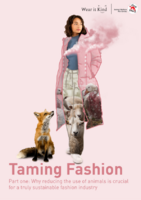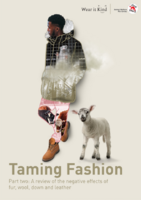
FAQ on Animal-derived materials
The truth about animal use in fashion and a sustainable way forward with next-gen materials
How does fashion impact animals?
Over 5 billion animals are used in fashion supply chains annually, and sadly most brands have little to zero knowledge of the conditions they’re raised, transported and killed. Key animal welfare concerns include:
- Fur farming is inherently cruel, and no fur animal welfare certification can provide animals on fur farms with a life worth living.
- Sheep in wool supply chains are regularly subjected to mutilations such as mulesing and castration without adequate pain relief as well as stressful shearing practices, and long-distant transport.
- Geese and ducks continue to be at risk of live plucking and force-feeding in down supply chains. Many also suffer for extended periods during poorly managed slaughter systems.
- Even ADMs that adhere to recognised animal welfare certifications continue to carry a significant risk, as existing standards are largely geared towards the removal of specific cruel practices, rather than ensuring suitable levels of animal welfare as determined by experts.
How does the use of animals for fashion impact the environment?
The current scale and nature of animal farming is both unsustainable for our planet and causes unnecessary animal suffering. Key environmental concerns include:
- Of the ADMs sourced from domesticated animals, materials from ruminants have a significant global warming impact, primarily due to the large quantities of methane they emit during digestion.
- Grazing large numbers of animals, contributes to major global land use change, deforestation and biodiversity loss, using the majority of the world’s agricultural land.
- The carbon footprint of producing feed for these farmed animals is significant and chemical fertilisers used in the production of animal feed contribute to eutrophication.
- Intensive animal farming requires significant amounts of water and can cause mass accumulation of faeces that can pollute local water bodies.
Resource intensive and environmentally damaging finishing processes
- Significant levels of heavy metals are used to process fur and hides including chemicals such as chromium and formaldehyde.
- Down is often processed using harsh chemicals, requires water-intensive methods to clean feathers, and involves extensive drying, all of which use significant amounts of water and electricity.
- Wool scouring, a resource-intensive step of wool processing, requires significant amounts of water and detergents to remove wool grease, a substance which is not readily biodegradable, and the combination can be harmful when disposed of.
- Wool is typically treated with synthetic substances to make it machine washable and comfortable to wear next to skin.
How does the use of animals for fashion impact people?
The fashion industry cannot be truly ethical unless it is inclusive of social and human rights, and there are many inherent social and human injustices in the industrialised production of ADMs, including their impact on public health, community environments, and supply chain workers.
- Public health: COVID-19 recently exposed the health risks associated with using animals at scale in global supply chains, including in the fashion industry. Large numbers of animals kept in cramped conditions are characteristic of intensive farming and can provide a breeding ground for harmful pathogens and zoonoses to spread. COVID-19 is the latest in a long string of animal-borne diseases such as swine flu and avian flu, which are making headlines once again due to various outbreaks across the world. Antibiotic resistance also poses a growing and alarming risk to human health, which is directly linked to livestock farming. The over-use and misuse of antibiotics in factory farms, aimed at mitigating disease outbreaks, is particularly prevalent in intensive farming settings.
- Impact on community environments: The environmental impacts of intensive farming and ADM production often disproportionately affect minority and low-income communities. For example, in an effort to export pollution problems, many tanneries are located in lower and middle-income countries where untreated wastewater is often released into waterways, impacting the health of surrounding land and communities.
- Impact on workers in ADM supply chains: Working within these intensive farming systems and supply chains are labourers who are often subjected to poor working conditions. Labour trafficking, debt bondage, and other forms of forced labour have all been reported in key ADM producing countries. Slaughterhouses are known for having a negative impact on the mental health of those who kill animals for a living, with many suffering from symptoms of traumatic stress. Tannery workers also suffer from exposure to toxic chemicals during the tanning process, with many at increased risk of cancer.
How aren't animal derived materials natural?
Animal-derived materials (ADMs) are far from their original ‘natural’ state by the time they are ready to be fashioned into clothing and accessories. In fact, ADMs need to be processed using highly toxic chemicals to prevent them from decaying and to give them the desired design qualities such as malleability, durability, or texture, and functional qualities such as being hypoallergenic or resistant to shrinkage. Here are some examples:
- In the extensive processing of fur, for example, significant levels of heavy metals such as chromium and formaldehyde are used. These toxic chemicals prevent fur pelts from decaying.
- In down processing, the down is subjected to several kinds of chemical treatments (as down can become more allergenic over time), and the chemicals involved can pose a major risk to human health.
In addition to the processing of ADMs, the intensive scale of farming animals is having a critical impact on our natural world. How can we call something natural when it’s having a devastating impact on nature?
If we don't use animals, are plastics our only other choice?
As fashion brands, designers, and consumers evaluate the impacts of raw materials used in the industry, they are increasingly looking to innovative new materials that can offer the same functionality and quality without the cost to animals, the environment, and people. This has led to the development of a new material category known as ‘next-gen materials.’
What are next-gen materials? According to the Material Innovation Initiative (MII), next-gen materials can be defined as environmentally preferred, “livestock-free direct replacements for conventional animal-based leather, silk, fur, down, wool, and exotic skins. Their primary inputs are usually plant-derived (such as cactus leather or wool like material made from Kapok fibre), mycelium, cultivated animal cells, microbe-derived, recycled material, or a blend of these materials, and a range of biomimicry approaches are used to replicate the aesthetics and performance of animal-derived counterparts.”
In fact, over 100 brands are now utilising next-gen materials, and in response to this increasing interest, acceleration of innovation, adaptation, and growth of next-gen materials and a rapidly growing number of highly innovative tech start-ups adopting ambitious and transformative approaches continues. Today there are 102 companies working to develop and/or scale up the production of next-gen materials and for most. There is no longer the need to choose between plastic use or animal suffering.
What is FOUR PAWS vision for the future of fashion?
The team at FOUR PAWS are working towards a fashion future which is kind to all animals. To achieve this, we need to see dramatic reductions in the use of animals across the board, in fashion and in food. Animal use in fashion is inextricably linked to food-based industries, both of which must reduce their reliance on the use of animals if we are to stay within planetary boundaries and avoid future climate catastrophes. We need a complete end to the use of wild animals, and for the domesticated animals who remain in fashion supply chains to be treated with respect, empathy and kindness. This means brands must ensure only to use domesticated animals where an excellent standard of animal welfare is assured, and right now certifications aren’t enough to enable this reality. That’s why our vision for the future of fashion includes certifications greatly lifting their game, and fashion brands going above and beyond to ensure animal welfare.


